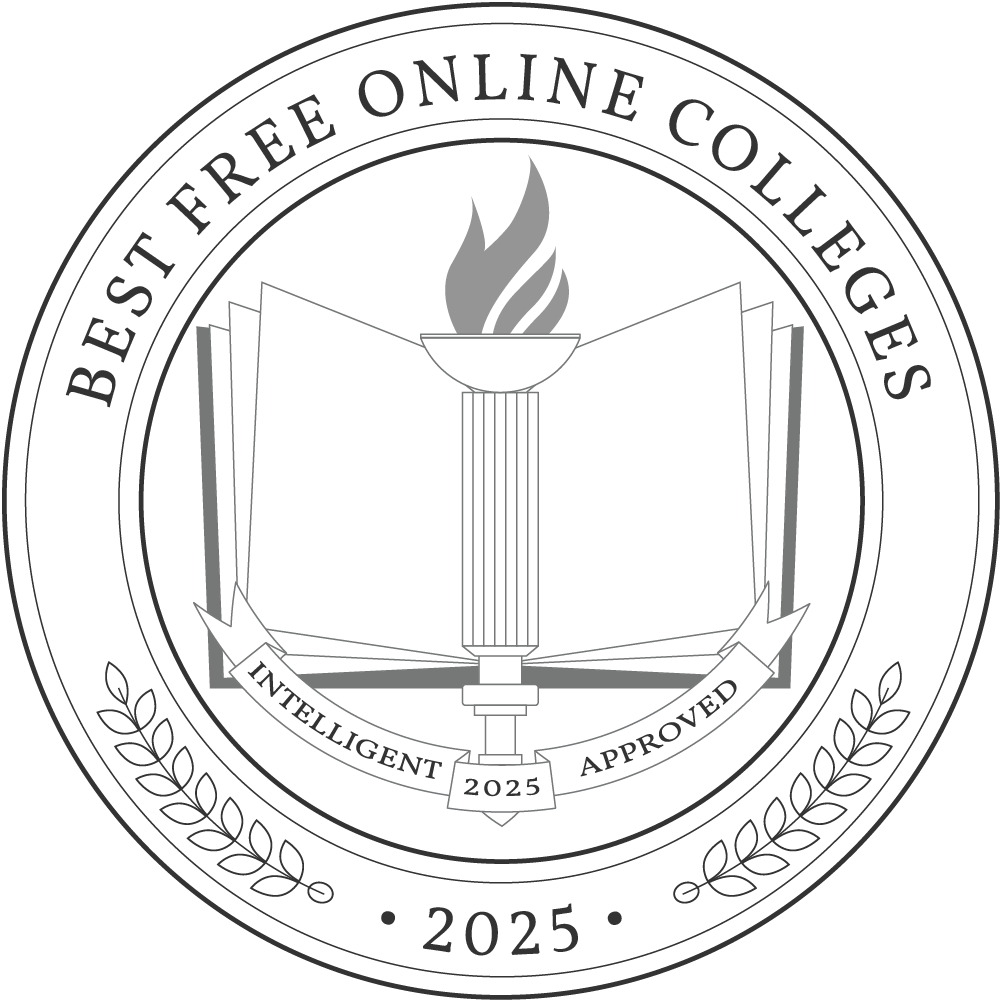One of the biggest barriers to earning a college degree is cost. However, depending on the school students attend and the financial resources they receive, students can significantly lower the cost of their degree or eliminate expenses altogether.
To help students find the most affordable online colleges, Intelligent.com compiled this list of the best free online colleges. We also offer insight into paying for college without borrowing student loans or paying out-of-pocket and review how enrolling in an online degree program can save students money.
How We Rank Colleges
This list features some of the country’s best free online colleges. Each school featured is a nonprofit, accredited institution, either public or private, with a high standard of academic quality for post-secondary institutions.
We evaluated each school’s program on tuition costs, admission, retention and graduation rates, faculty, and reputation. Then, we calculated the Intelligent Score on a scale of 0 to 100. Read more about our ranking methodology.
Next, we compared this comprehensive list of the best free online colleges to a list of aggregated college rankings from reputable publications, such as U.S. News & World Report, to simplify a student’s college search. We pored through these rankings so students don’t have to.
The 50 Best Free Online Colleges

What You Should Know About Free Online Colleges
Attending college for free typically means that a student receives enough financial support from the institution and other sources to fully cover the program’s cost, not that the school doesn’t charge tuition and fees for attendance. Students should carefully research any colleges that claim to offer degrees without charging tuition, as this is rare among legitimate post-secondary institutions.
For students who want to lower the costs of attending an online college as much as possible so they don’t have to pay out-of-pocket or borrow student loans, the most common ways to achieve this include:
Scholarships and grants
This type of college funding is considered gift aid because it doesn’t need to be repaid. Getting scholarships or grants means receiving free money to pay for tuition and other educational-related expenses.
There are two types of scholarships — need-based and merit-based. In most cases, students who are applying for scholarships based on financial need must submit the Free Application for Federal Aid (FAFSA). Schools and other scholarship-granting organizations use the information from the FAFSA to determine which students are eligible for need-based scholarships.
Schools and organizations award merit-based scholarships for achievement in various areas, including academics, athletics, arts, community service, or unique talents. Students may submit separate applications, including essays, resumes, and interviews, to be considered for merit-based scholarships.
Grants are typically awarded based on financial need, although some may also have specific eligibility criteria, such as academic achievement or community service. Many grants are offered by federal or state governments, as well as private organizations, foundations, and corporations. Submitting the FAFSA is also a prerequisite for most grant consideration.
The Federal Pell Grant is the federal government’s primary need-based grant, which helps low-income students pay for college. The amount of the Pell Grant varies depending on the student’s financial need, the cost of attendance, and whether the student is enrolled full- or part-time. For the 2024-25 academic year, the maximum Pell Grant award is $7,395.
Students should give themselves ample time to research all options for scholarships and grants, as there is no limit to how much funding students can collect. Depending on the program’s cost and the amount of scholarship money received, it may be possible to cover all tuition and education expenses with scholarships. However, most scholarships and grants have specific application requirements and deadlines.
Fellowships and assistantship
Fellowships and assistantships are primarily available at the graduate level for students pursuing master’s or doctoral degrees. They cover students’ tuition expenses or pay students wages in exchange for working as teaching or research assistants.
The terms and availability of these opportunities will vary by school and program but may cover students’ tuition expenses fully or partially. There can be a lot of competition for fellowships, especially those that fully fund a student’s education, so it’s important to research these opportunities early and prepare the strongest application possible.
Employer tuition assistance benefits
Many employers, including prominent companies like Apple, Disney, Wal-Mart and more, offer tuition assistance and reimbursement benefits to employees seeking higher education. While the specific terms of the tuition assistance benefits will vary by employer, in most cases, employers reimburse employees for some or all of their tuition costs and related expenses after successfully completing a course or program. Some companies pay for employees to get degrees regardless of the area of study, while others will only reimburse employees whose degree directly relates to their industry or role within the company.
Students who plan on working while attending an online college should consult with their company’s HR representative or benefits manager to find out if these benefits are available and if they are eligible. If you’re planning long-term, seek out a job at a company offering tuition assistance benefits to prepare for college.
Prior learning assessment
Prior learning assessment, or PLA, refers to experience you have gained outside of college, such as workforce or military experience. Increasingly, colleges and universities offer credit for these experiences if they are related to your program. It can save you time and money, helping you to earn your degree more quickly while taking fewer courses.
PLA can also be given to students who took college-level courses in high school, such as Advanced Placement (AP) or International Baccalaureate (IB) courses. Students take exams at the end of these courses, and if they pass satisfactorily, they may receive college credit for their work. Similarly, students may also look into the College-Level Examination Program (CLEP) tests for additional examination credit opportunities.
Work-study
The Federal Work-Study Program offers part-time jobs, often on campus, to undergraduate and graduate students with financial need. The jobs pay at least the current federal minimum wage but often pay more, especially for graduate students. The amount you earn through the program is determined by submitting your FAFSA and depends on both your level of financial aid and your school’s funding level.
Although work-study funding is intended to help you pay for your degree, you will receive your salary directly and can use the money as you wish. Many students use their work-study funding to pay for books or tuition expenses.
While not all students will be eligible for work-study based on their family finances, our professional recommendation is to always check the box “yes” to show that you’d like to be considered. If it is offered to you and you’d rather not participate, you can always turn it down later — but if you don’t check that box, they won’t even check to see if you’re eligible.
Avoid Non-Accredited Degree Mills
As mentioned previously, legitimate accredited colleges rarely advertise programs as “free.” Instead, this is a deceptive claim made by private, for-profit “degree mills” that operate like postsecondary institutions even though they don’t have the proper accreditation to award legitimate degrees.
Degree mills focus more on generating revenue than providing high-quality education. They often attract users by advertising free tuition, only to charge an assortment of other fees (exam fees, graduation fees, etc.).
However, they typically lack qualified faculty, effective curriculums, and sufficient support staff. It can result in students wasting time on degree programs that don’t teach the skills they need to lead to gainful employment. Students may be unable to transfer their credits at degree mills to other accredited schools, leading to further disruption in their education.
The most reliable way to confirm that a college is legitimate is by checking with an accreditation database, such as the Council for Higher Education Accreditation (CHEA) or the U.S. Department of Education’s Database of Accredited Postsecondary Institutions and Programs (DAPIP). Students who plan to continue earning a bachelor’s degree after getting their associate degree should select a regionally accredited college, as this is the most widely accepted type of accreditation.
Another clue to a college’s legitimacy is its domain name. The websites for legitimate educational institutions end in “.edu.” A school domain name that ends in “.org” or “.com” is typically a red flag that it’s not legitimate.
Why You Should Earn Your Degree Online
Ultimately, deciding to earn a degree online is a personal choice based on a student’s needs and priorities. However, there are some advantages to earning an online degree that are worth considering:
Flexible scheduling
Many online programs deliver coursework through asynchronous courses. These classes offer instruction through pre-recorded lectures, videos, and reading assignments that can be accessed at whatever time is most convenient for the student. It makes them an excellent option for adult students in the workforce or with family commitments. Students can study and do classwork as their schedule allows without needing to be in a specific location at a particular time. Many asynchronous programs are also self-paced, meaning there is flexibility in completing assignments and exams.
Other online programs instruct students through synchronous virtual classes, which meet online at designated times each week. While this means students must work their class meetings into their schedule, they can participate in the classes from wherever is convenient for them. Students don’t have to take time out of their schedule to commute to and from campus, and they don’t have to relocate if the school offering their desired program isn’t local.
Save time
Commuting to and from campus can take up a lot of time, which may not be feasible for students who work full-time or have family caregiving responsibilities. To participate in online courses, students just need to find a quiet, convenient, accessible location in their own home, workplace, or public library. Once class is over or they complete their work for the day, students can easily return to their other responsibilities and activities.
Although some students prefer the full traditional college experience of living in a dorm, participating in on-campus activities, and learning in an interactive environment, for those focused solely on earning a degree, an online program can be an ideal way to accomplish this goal.
Save money
Although the tuition for an online degree program may be the same as that of a traditional degree program, there are several ways earning a degree remotely can save students money.
Students can live anywhere, including a place that may be more affordable than where their school is located. Not having to commute to campus saves money on gas, parking, or public transportation. It may also make it easier for students to maintain a steady income with a full-time job because they can schedule their schoolwork around their work schedule.
Some online programs are offered in an accelerated format, which allows students to complete their degrees faster, reducing overall tuition and fee costs.


